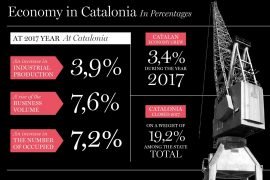
Barcelona has been an outstanding entrepreneurial centre for the technology...
In its fourth edition, the Audiovisual Talent Week, maintains the...

The Catalan economy grew 3.4% in 2017 according to estimates...

“Offering this skill in Amazon Alexa allows us to provide...

Maybe because of tradition, or because of its huge media...

Approved by the Executive Committee, the principles underscore gender equality...

The German city of Freiburg has become an example of...

La universidad norteamericana publica un caso de estudio que analiza...
Álvaro Pascual-Leone, neurologist: "We know that the brain is intrinsically...

The Yes! Programme of the SHE Foundation, a school intervention...

Música clásica sobre la arena de la playa en dos...

The first session of the cycle on the regatta organized...

The hospital's managing director, Manel del Castillo, and the pharmaceutical...

Generalitat y Ayuntamiento impulsarán dos equipamientos de 'Casa de les...

Leticia Beleta, director of Alexion Pharmaceuticals in Spain and Portugal,...

We all have a friend who never leaves the Gràcia...

Barcelona director opts for Best International Film with 'La sociedad...

The hotel and industrial sectors softened the market's decline last...

The technology company, with a workforce of 35 employees and...

“The women of yesteryear were strong and had to fight...
For the past few months, the media have been obsessed with the concepts of GENDER EQUALITY and WAGE GAP: perhaps the demonstrations and actions of the Hollywood actresses have helped, joined by the rest of the Western world; or perhaps it’s because of the Icelandic law which penalises companies which have a wage gap; or perhaps it’s the commemoration of the 8th of March, INTERNATIONAL WOMEN’S DAY; or perhaps a greater awareness in society; or perhaps a combination of all of the above. But this reporting is having a multiplying effect, and only time will tell whether it is just a mirage or will truly prove to be a huge step towards true GENDER QUALITY, always coupled with EQUAL OPPORTUNITIES and the beginning of the end of the WAGE GAP.
We all more or less know what gender equality means, or at least what it refers to, but the wage gap is a newer term for the public at large. What is the wage gap? Why does it exist? How is it quantified? How important is it? These are questions that are becoming more fashionable and this current visibility may mark a milestone in getting rid of it.
Women did not join the job market en masse until the 19th century with the proliferation of factories, although they did so earning minuscule salaries and under extremely poor conditions
The wage gap is the situation of wage inequality between men and women, and it can only be understood through gender inequality. That is, it is yet another factor stemming from gender inequality.
In prehistory, back when we were primitive, or at least more primitive than we are today, women stayed to care for the home and men went out to hunt to feed the family. Thousands of years have gone by and yet women did not join the job market en masse until the 19th century with the proliferation of factories, although they did so earning minuscule salaries and under extremely poor conditions. Gradually, during the first third of the 20th century, jobs that were maliciously ideal for women were created, like receptionists, secretaries, nurses and teachers. Gradually, the feminist movement promoted the need for women to get educated, and there was a burgeoning number of women who wanted higher education in order to access professional-grade white-collar jobs. After the Spanish Civil War, 1936-39, the role of women went back to a period of curtailed freedom, where they had to ask their father or perhaps their spouse for permission to leave the country, open a bank account and even work. Likewise, certain professions were off-limits to women, such as judges and notaries. It was common for single women to work and to stop working once they got married, viewing this as a badge of honour since their husband could be the sole breadwinner and provider of the family’s economic wellbeing while the women could tend to the house. The role of the housewife and caregiver was glorified, with her sweet, docile, submissive character. There was no need for much education and in any case, if women were educated, it could help them snag a husband.
There are currently more women with professional careers than men, but curiously the powerful political and economic jobs are held by men.
The unequal compensation for men and women with equal personal and professional qualities is called direct discrimination, as sex is the only distinction that determines it. These situations may still exist but fortunately they are less and less common.
Applying criteria and/or practices that are apparently neutral but leave women at a disadvantage compared to men is called indirect discrimination.
Wage inequality is characterised by a very different pattern of job insertion and career paths between men and women due to a wide array of obstacles that women come upon, such as the glass ceiling and roles and stereotypes accepted and internalised by society, and even by women themselves, which place them at a lower rank than men in their career and personal development.
Let us examine some of these obstacles:
BELIEFS, ROLES AND STEREOTYPES
Roles and stereotypes begin to be inculcated in childhood, through toys which play a segregating role, with certain colours and pictures of boys or girls and masculine or feminine language (for example, construction games and chemical sets for boys and kitchens and hairdressing toys for girls). It is also found in the advertisements for these toys, which clearly refer to the roles perfectly classified by the toys, as well as in the parents’ choice of the best toys and games, which are classified by sex. The quality of male games is highlighted as action and construction and feminine games are caring for dolls, playing at hair dressing, kitchens and other pretty things geared at feminine jobs. It further happens by promoting phrases like “boys don’t cry” or “girls don’t fight”, behaviours regarded as masculine or feminine which always assigning strength and denial of sensibility to boys and glorifying the obliging, docile attitude for girls. Finally, it would be unforgiveable to fail to mention the stories where the courage of the hero who saves the day is exalted, as is the beauty and docility of the heroine.
There are attitudes that are regarded as positive in men which become negative in women, such as:
In short, despite the acknowledged influx of women into the public sphere and paid work, there is still a sexual division of labour and a lack of value assigned to the roles and values traditionally considered feminine.
A liberal education with a focus on equality, where it is not assumed that women cannot excel in technical professions that require talent in mathematics and physics, as well as a rectification in many TV programmes and advertisements that objectify women, would clearly help debunk these beliefs and stereotypes, which in the worst cases make women the victims of physical and/or psychological violence.
HORIZONTAL SEGREGATION
These beliefs, roles and stereotypes have been handed down throughout history from parents to children. Women have been assigned the role of caregivers of the family and other people, while men are labelled as leaders, rulers and communicators. The outcome of this is that we find horizontal segregation in the job market; that is, women are mostly found in jobs characterised by lower compensation and social value, and jobs are largely an extension of the activities that have traditionally and socially been assigned to each sex.
Therefore, there are jobs that are considered feminised, such as caregiving and administrative services. They are under-valued and therefore have low wages compared to jobs with a similar value which have higher wages precisely because they are regarded as masculinised.
In Catalonia, women account for 77.5% of employees in healthcare and social services, around 70% in cultural and sports activities and other services, and 66.2% in retail.

BALANCING WORK AND FAMILY LIFE
This is another factor that increases inequality at work given that both traditionally and even today women are the ones who spend the most time on housework and care of children or dependent family members. Thus, they are required to take work-family balance measures that foster lower participation in the job market, such as requesting leaves of absence and part-time workdays or interrupting their careers. This directly influences the wage gap, lower the opportunities for promotion and employment in managerial posts and earns women lower pensions.
Women continue joining the job market in lower numbers and having a lower employment rate than men, yet they are still the majority of the unemployed population.
True balance comes from CO-RESPONSIBILITY, in which family work is equitable for men and women. It is not trivial to mention that many men are increasingly conscious of this, especially in childcare, as well as joint custody in divorces which stipulate equal care. However, the horizon is still far away.
Likewise, even though men are progressing and participating more in childcare, oftentimes due to divorces with joint custody, the same progress in the care of the elderly cannot be found, and women are usually in charge of caring for old folks.
PART-TIME WORK
If we add up the paid and unpaid hours of work (household work and care of the family), women have a much longer, harder workday than men, even if men stay at work longer. Most part-time contracts are for women. According to figures from ADECA (4th quarter of 2016), 7 out of every 10 part-time contracts are signed by women.
Much of the gender-based wage gap can be explained by the different workdays, but not all of it.
GLASS CEILING – VERTICAL SEGMENTATION
Women not only have the most low-skilled jobs; they also have less access to jobs with greater responsibility and are under-represented at the highest salary echelons due to what is called the glass ceiling. The glass ceiling means invisible barriers that women encounter when trying to carve out a professional career and get promoted to jobs with more responsibility.
A study performed by Grant Thornton stated that the presence of women at executive levels in companies is stagnant.
Even if women have more university degrees than men, as mentioned above, this has no direct relationship with their occupying executive positions.
A study performed by the ASSOCIATION OF ASSOCIATIONS AND FEDERATIONS OF THE MEDITERRANEAN (AFAEMME) on the benefits of having women in executive jobs concludes with seven benefits for companies, namely:
SALARY PERKS
Salary perks are one of the most important components of the wage gap, even if it is a lesser component of salary.
Salary perks are often granted on discretionary grounds, and most of them run to the detriment of women. Likewise, other times aspects like working at night, seniority, physical effort or availability are rewarded, aspects which are clearly “masculinised”, while “feminised” qualities such as accuracy and stamina are not taken into account.
For the past few months, the media have been obsessed with the concepts of GENDER EQUALITY and WAGE GAP: perhaps the demonstrations and actions of the Hollywood actresses have helped, joined by the rest of the Western world; or perhaps it’s because of the Icelandic law which penalises companies which have a wage gap; or perhaps it’s the commemoration of the 8th of March, INTERNATIONAL WOMEN’S DAY; or perhaps a greater awareness in society; or perhaps a combination of all of the above. But this reporting is having a multiplying effect, and only time will tell whether it is just a mirage or will truly prove to be a huge step towards true GENDER QUALITY, always coupled with EQUAL OPPORTUNITIES and the beginning of the end of the WAGE GAP.
We all more or less know what gender equality means, or at least what it refers to, but the wage gap is a newer term for the public at large. What is the wage gap? Why does it exist? How is it quantified? How important is it? These are questions that are becoming more fashionable and this current visibility may mark a milestone in getting rid of it.
Women did not join the job market en masse until the 19th century with the proliferation of factories, although they did so earning minuscule salaries and under extremely poor conditions
The wage gap is the situation of wage inequality between men and women, and it can only be understood through gender inequality. That is, it is yet another factor stemming from gender inequality.
In prehistory, back when we were primitive, or at least more primitive than we are today, women stayed to care for the home and men went out to hunt to feed the family. Thousands of years have gone by and yet women did not join the job market en masse until the 19th century with the proliferation of factories, although they did so earning minuscule salaries and under extremely poor conditions. Gradually, during the first third of the 20th century, jobs that were maliciously ideal for women were created, like receptionists, secretaries, nurses and teachers. Gradually, the feminist movement promoted the need for women to get educated, and there was a burgeoning number of women who wanted higher education in order to access professional-grade white-collar jobs. After the Spanish Civil War, 1936-39, the role of women went back to a period of curtailed freedom, where they had to ask their father or perhaps their spouse for permission to leave the country, open a bank account and even work. Likewise, certain professions were off-limits to women, such as judges and notaries. It was common for single women to work and to stop working once they got married, viewing this as a badge of honour since their husband could be the sole breadwinner and provider of the family’s economic wellbeing while the women could tend to the house. The role of the housewife and caregiver was glorified, with her sweet, docile, submissive character. There was no need for much education and in any case, if women were educated, it could help them snag a husband.
There are currently more women with professional careers than men, but curiously the powerful political and economic jobs are held by men.
The unequal compensation for men and women with equal personal and professional qualities is called direct discrimination, as sex is the only distinction that determines it. These situations may still exist but fortunately they are less and less common.
Applying criteria and/or practices that are apparently neutral but leave women at a disadvantage compared to men is called indirect discrimination.
Wage inequality is characterised by a very different pattern of job insertion and career paths between men and women due to a wide array of obstacles that women come upon, such as the glass ceiling and roles and stereotypes accepted and internalised by society, and even by women themselves, which place them at a lower rank than men in their career and personal development.
Let us examine some of these obstacles:
BELIEFS, ROLES AND STEREOTYPES
Roles and stereotypes begin to be inculcated in childhood, through toys which play a segregating role, with certain colours and pictures of boys or girls and masculine or feminine language (for example, construction games and chemical sets for boys and kitchens and hairdressing toys for girls). It is also found in the advertisements for these toys, which clearly refer to the roles perfectly classified by the toys, as well as in the parents’ choice of the best toys and games, which are classified by sex. The quality of male games is highlighted as action and construction and feminine games are caring for dolls, playing at hair dressing, kitchens and other pretty things geared at feminine jobs. It further happens by promoting phrases like “boys don’t cry” or “girls don’t fight”, behaviours regarded as masculine or feminine which always assigning strength and denial of sensibility to boys and glorifying the obliging, docile attitude for girls. Finally, it would be unforgiveable to fail to mention the stories where the courage of the hero who saves the day is exalted, as is the beauty and docility of the heroine.
There are attitudes that are regarded as positive in men which become negative in women, such as:
In short, despite the acknowledged influx of women into the public sphere and paid work, there is still a sexual division of labour and a lack of value assigned to the roles and values traditionally considered feminine.
A liberal education with a focus on equality, where it is not assumed that women cannot excel in technical professions that require talent in mathematics and physics, as well as a rectification in many TV programmes and advertisements that objectify women, would clearly help debunk these beliefs and stereotypes, which in the worst cases make women the victims of physical and/or psychological violence.
HORIZONTAL SEGREGATION
These beliefs, roles and stereotypes have been handed down throughout history from parents to children. Women have been assigned the role of caregivers of the family and other people, while men are labelled as leaders, rulers and communicators. The outcome of this is that we find horizontal segregation in the job market; that is, women are mostly found in jobs characterised by lower compensation and social value, and jobs are largely an extension of the activities that have traditionally and socially been assigned to each sex.
Therefore, there are jobs that are considered feminised, such as caregiving and administrative services. They are under-valued and therefore have low wages compared to jobs with a similar value which have higher wages precisely because they are regarded as masculinised.
In Catalonia, women account for 77.5% of employees in healthcare and social services, around 70% in cultural and sports activities and other services, and 66.2% in retail.

BALANCING WORK AND FAMILY LIFE
This is another factor that increases inequality at work given that both traditionally and even today women are the ones who spend the most time on housework and care of children or dependent family members. Thus, they are required to take work-family balance measures that foster lower participation in the job market, such as requesting leaves of absence and part-time workdays or interrupting their careers. This directly influences the wage gap, lower the opportunities for promotion and employment in managerial posts and earns women lower pensions.
Women continue joining the job market in lower numbers and having a lower employment rate than men, yet they are still the majority of the unemployed population.
True balance comes from CO-RESPONSIBILITY, in which family work is equitable for men and women. It is not trivial to mention that many men are increasingly conscious of this, especially in childcare, as well as joint custody in divorces which stipulate equal care. However, the horizon is still far away.
Likewise, even though men are progressing and participating more in childcare, oftentimes due to divorces with joint custody, the same progress in the care of the elderly cannot be found, and women are usually in charge of caring for old folks.
PART-TIME WORK
If we add up the paid and unpaid hours of work (household work and care of the family), women have a much longer, harder workday than men, even if men stay at work longer. Most part-time contracts are for women. According to figures from ADECA (4th quarter of 2016), 7 out of every 10 part-time contracts are signed by women.
Much of the gender-based wage gap can be explained by the different workdays, but not all of it.
GLASS CEILING – VERTICAL SEGMENTATION
Women not only have the most low-skilled jobs; they also have less access to jobs with greater responsibility and are under-represented at the highest salary echelons due to what is called the glass ceiling. The glass ceiling means invisible barriers that women encounter when trying to carve out a professional career and get promoted to jobs with more responsibility.
A study performed by Grant Thornton stated that the presence of women at executive levels in companies is stagnant.
Even if women have more university degrees than men, as mentioned above, this has no direct relationship with their occupying executive positions.
A study performed by the ASSOCIATION OF ASSOCIATIONS AND FEDERATIONS OF THE MEDITERRANEAN (AFAEMME) on the benefits of having women in executive jobs concludes with seven benefits for companies, namely:
SALARY PERKS
Salary perks are one of the most important components of the wage gap, even if it is a lesser component of salary.
Salary perks are often granted on discretionary grounds, and most of them run to the detriment of women. Likewise, other times aspects like working at night, seniority, physical effort or availability are rewarded, aspects which are clearly “masculinised”, while “feminised” qualities such as accuracy and stamina are not taken into account.
